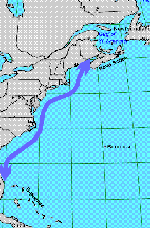
Today's News

Spring's Journey North

Report Your Sightings

Search Journey North
return to:

 A/CPB
A/CPB
Right Whale Migration Update: March 18, 1998
Today's Report Includes:
- Migration News About Right Whale Mother-calf Pairs
- Challenge Question #4
- Sightings in Cape Cod Bay
- Discussion of Challenge Questions #2 and #3
To: Journey North
From: Anne Smrcina
Greetings from the Stellwagen Bank National Marine Sanctuary.
Migration News About Right Whale Mother-calf Pairs
 |
|
Migration Route of North Atlantic Right Whales Map courtesy of |
The five mother-calf pairs spotted in the southern calving grounds have been
identified. Three of those mothers are:
| Mother | Background |
| #1315 | Born in 1983, last seen in '92 with her first calf |
| #1233 | First seen in 1974, last seen in '92 with her second calf |
| #1321 | Also known as "Mono." |
Only 5 calves were identified this season (and one additional calf, which is presumed to have been stillborn). Last year there were over 20 births recorded down in the calving grounds. Because there are only an estimated 300 whales in this endangered population, reproduction is watched carefully.
Although the numbers this year don't look too good initially, researchers are still holding out for positive numbers. A string of storms and bad weather days made it impossible to put the plane in the air for the aerial surveys. Fewer days in the air translated into fewer sightings. Also, even on the days the plane got airborne, the sea states were often quite bad for whale spotting. A sea state of 3 or more, which was often the case, results in whitecaps. Whitecaps disguise the splashes whales make when they break the surface. So, except for the whales the observers flew directly over, many of the whales were probably camouflaged by the choppy seas. Researchers are hoping to see many more mother-calf pairs in northern waters this spring and summer. Here's a Challenge Question for you:
Challenge Question #4
"If the mother-calf pairs are traveling from Cape Canaveral to Provincetown, how far are they going? Assuming a rate of 25 nautical miles a day, how long will it take them to make the trip?"
(To respond to this question, please follow the instructions at the end of this report.)
Sightings in Cape Cod Bay
Adult and juvenile whales (animals whose winter destinations are not known) are still being found in numbers up
in Cape Cod Bay. Here too, bad weather has prevented many boat and aerial surveys. Whales seem to be feeding
on abundant zooplankton in the waters here. On March 13th three whales were seen, two at the southern edge of
Stellwagen Bank and one in the Bay:
42 09N, 70 17W
41 51N, 70 16W
Discussion of Challenge Questions #2 & #3
Challenge Question #2 asked, "How deep is the water where right whales were spotted at 41 53N, 70 22W?"
[Editor's Apology: These numbers were mistakenly converted to decimal degrees in our last report, but should
have been left as degrees and minutes as shown above.] The point 41 53N, 70 22W is within Cape Cod Bay and
has a depth of about 32 meters (35.2 yards or 105.6 feet).
Challenge Question #3
As mentioned in my last report, two SOUTBOUND right whales were observed by a tugboat in the Ambrose/Barnegat Traffic
Lanes on Feb. 28th. Why might the right whales be heading south when most scientists believe this is the time for
the whales' northward migration?
Right whales are mammals, and mammals don't always do what we assume they are going to do. Unlike monarch butterflies
and other species that seem to be "programmed" on an unswerving course northward, whales often get side-tracked.
One whale swam up the Delaware River towards Philadelphia one year. Another mother-calf pair made their northward
migration and then took a side trip back south towards the Chesapeake Bay area. Metompkin, whose travels were
recorded by a WhaleNet satellite tag two years ago (see the WhaleNet home page at whale.wheelock.edu) appears to
have travelled out into the mid-Atlantic Ocean.
We are only just beginning to understand these whales, and often in trying to answer one question we raise many
more. There is much to learn -- perhaps some of you may provide the answers in the future.
Until my next report, this is Anne Smrcina, education coordinator of the Stellwagen
Bank National Marine Sanctuary signing off.
How to Respond to Today's Challenge Question
1. Address an e-mail message to: jn-challenge-rwhale@learner.org
2. In the Subject Line of your message write: Challenge Question # 4
3. In the body of the message, give your answer to this question:
Challenge Question #4
"If the mother-calf pairs are traveling from Cape Canaveral to Provincetown, how far are they going? Assuming a rate of 25 nautical miles a day, how long will it take them to make the trip?"
The Next Right Whale Update will Be Posted on April 1, 1998.



